Mitsubishi Motors Bundle
Who Really Owns Mitsubishi Motors?
Understanding the ownership structure of a major automotive player like Mitsubishi Motors is crucial for investors and industry watchers alike. The Mitsubishi Motors SWOT Analysis reveals how its ownership has shaped its strategic direction and market position. Unraveling the intricacies of Mitsubishi ownership provides critical insights into its future.
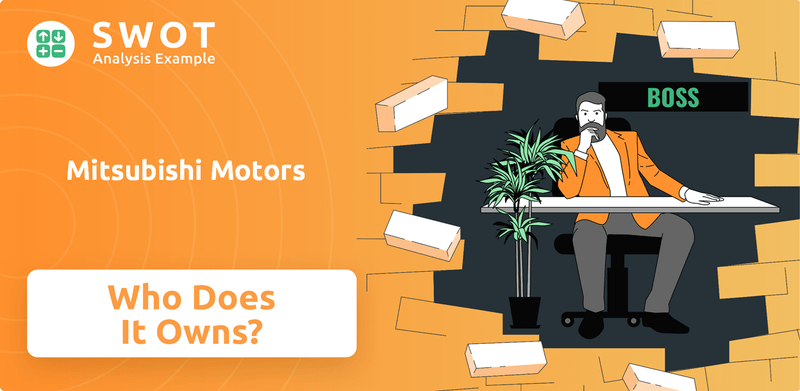
From its origins within Mitsubishi Heavy Industries to the pivotal Nissan acquisition, the story of Mitsubishi Motors' ownership is a dynamic one. This evolution, impacted by significant shifts in its Mitsubishi parent company and the rise of the Nissan-Renault-Mitsubishi Alliance, provides a fascinating case study. Exploring the Mitsubishi Motors ownership structure unveils how these changes have influenced its operations, financial performance, and strategic outlook, making it a compelling topic for anyone interested in the automotive industry.
Who Founded Mitsubishi Motors?
The story of Mitsubishi Motors begins within the larger Mitsubishi zaibatsu, a major Japanese industrial and financial conglomerate. Unlike a typical startup, the automotive division emerged from Mitsubishi Heavy Industries (MHI). MHI itself traces back to the original Mitsubishi organization founded by Yataro Iwasaki in 1870.
Early Mitsubishi Motors ownership was primarily held by Mitsubishi Heavy Industries. When Mitsubishi Motors Corporation was formally established as a separate entity in 1970, it was spun off from MHI. This initial structure meant that MHI held a significant stake in the newly formed automotive company. Specific equity splits or shareholding percentages at its exact inception are not readily available as a public offering, but rather it was an internal restructuring within the Mitsubishi group.
Early agreements within the Mitsubishi conglomerate focused on the strategic alignment and operational independence of the new automotive entity. This was all within the broader group's vision of contributing to Japan's industrial growth. The founding team, as part of the larger Mitsubishi philosophy, emphasized long-term stability, technological advancement, and a commitment to quality.
Mitsubishi Motors' roots are firmly planted in the Mitsubishi zaibatsu, a powerful industrial conglomerate.
Initially, Mitsubishi Heavy Industries (MHI) held the primary ownership stake in Mitsubishi Motors.
In 1970, Mitsubishi Motors was established as a separate entity, spun off from MHI.
The early focus was on contributing to Japan's industrial growth and technological advancement.
The core values included long-term stability and a commitment to quality.
Early agreements within the Mitsubishi group focused on strategic alignment and operational independence.
The initial ownership structure of Mitsubishi Motors was deeply intertwined with the larger Mitsubishi group. The company's history is detailed further in Brief History of Mitsubishi Motors. The early years saw Mitsubishi Heavy Industries as the major shareholder, reflecting the internal restructuring within the Mitsubishi conglomerate. While specific percentages from the inception are not readily available due to the nature of the internal restructuring, the influence of MHI was substantial. The focus in those early days was on establishing a strong foundation for the automotive business within the broader Mitsubishi vision. The company's commitment to quality and technological advancement was evident from the start, setting the stage for its future growth and development.
Understanding the early ownership structure of Mitsubishi Motors provides crucial context for its development.
- Mitsubishi Motors emerged from Mitsubishi Heavy Industries.
- MHI held a significant ownership stake initially.
- The early focus was on long-term stability and quality.
- The ownership structure was an internal restructuring within the Mitsubishi group.
Mitsubishi Motors SWOT Analysis
- Complete SWOT Breakdown
- Fully Customizable
- Editable in Excel & Word
- Professional Formatting
- Investor-Ready Format
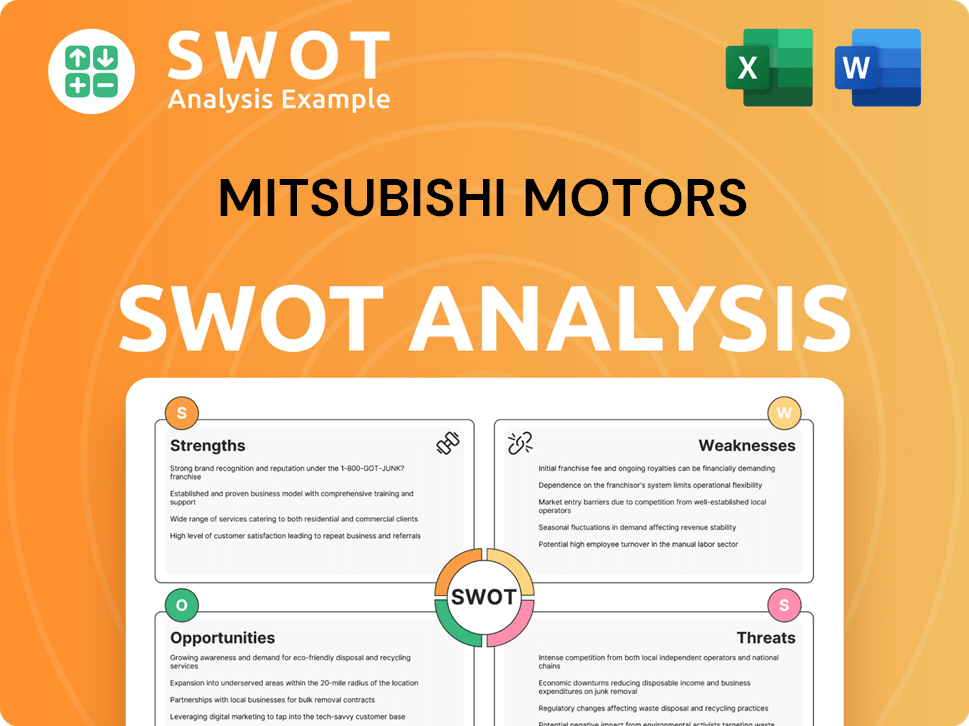
How Has Mitsubishi Motors’s Ownership Changed Over Time?
The evolution of Mitsubishi Motors' ownership is marked by significant shifts, especially after its initial public offering (IPO) in 1988. Initially, ownership was primarily within the Mitsubishi group. However, the IPO opened the door for a more diverse shareholder base, although Mitsubishi group companies, such as Mitsubishi Heavy Industries, Mitsubishi Corporation, and MUFG Bank, continued to hold considerable stakes. This structure began to change dramatically in 2016.
The most transformative event was Nissan Motor Co., Ltd.'s acquisition of a 34% equity stake in Mitsubishi Motors Corporation. This move, prompted by a fuel economy scandal, cost Nissan approximately 237 billion yen. This acquisition made Nissan the largest shareholder and led to the formation of the Renault-Nissan-Mitsubishi Alliance. As of late 2024 and early 2025, Nissan maintains this significant stake, reshaping Mitsubishi Motors' strategic direction.
| Year | Event | Impact on Ownership |
|---|---|---|
| 1988 | IPO on Tokyo Stock Exchange | Diversified ownership beyond the Mitsubishi group. |
| 2016 | Nissan acquires a 34% stake | Nissan becomes the largest shareholder; formation of the Renault-Nissan-Mitsubishi Alliance. |
| 2024-2025 | Current Ownership | Nissan maintains a 34% stake, Mitsubishi Heavy Industries and other Mitsubishi group companies hold significant shares. |
The acquisition by Nissan in 2016 profoundly impacted Mitsubishi Motors' strategy. This led to increased collaboration within the Alliance. This collaboration includes platform sharing, technology development, and market strategies. These efforts aim for synergies and cost reductions. Other institutional investors and mutual funds also hold shares, reflecting the typical ownership structure of a publicly traded company. For more context, you can explore the Competitors Landscape of Mitsubishi Motors.
Nissan is the largest shareholder of Mitsubishi Motors, holding a 34% stake. This acquisition occurred in 2016, following a fuel economy scandal. The Renault-Nissan-Mitsubishi Alliance was formed as a result.
- Mitsubishi Heavy Industries remains a significant shareholder.
- Other institutional investors and mutual funds also hold shares.
- The acquisition by Nissan has led to increased collaboration within the Alliance.
- The current ownership structure reflects a mix of strategic and institutional investors.
Mitsubishi Motors PESTLE Analysis
- Covers All 6 PESTLE Categories
- No Research Needed – Save Hours of Work
- Built by Experts, Trusted by Consultants
- Instant Download, Ready to Use
- 100% Editable, Fully Customizable
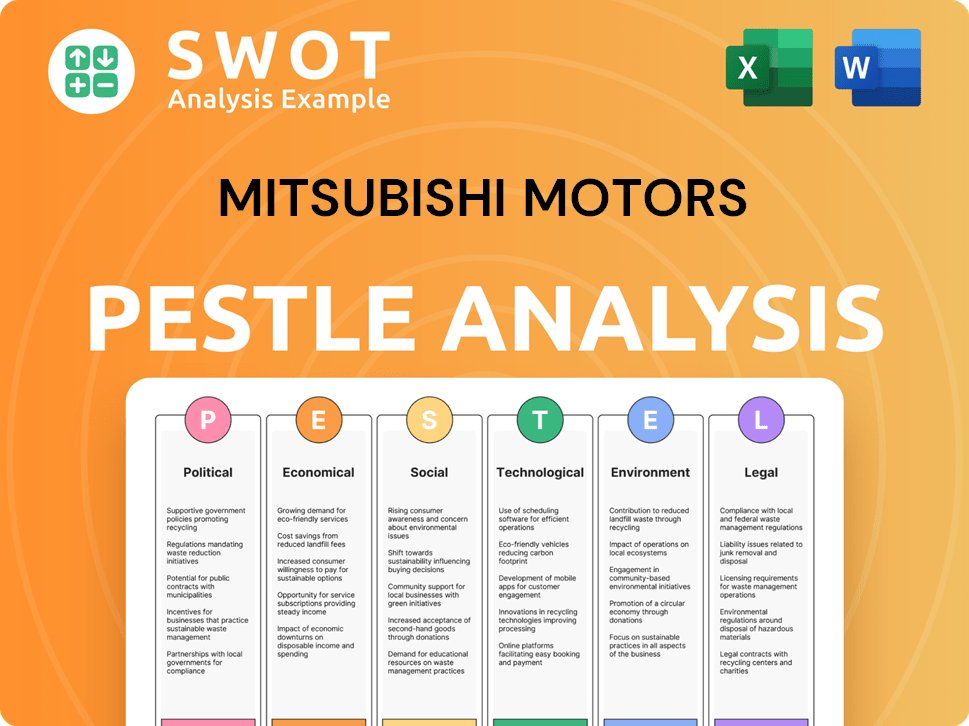
Who Sits on Mitsubishi Motors’s Board?
The current board of directors of Mitsubishi Motors Corporation reflects its ownership structure. As of April 2025, the board includes executive directors from Mitsubishi Motors, alongside external directors. Some external directors are appointed by Nissan to represent its substantial shareholding. Individuals with backgrounds linked to Nissan or the Alliance often hold key positions or board seats, ensuring Nissan's strategic interests are represented in decision-making. This structure is a direct result of the Mitsubishi ownership by Nissan.
The composition of the board directly influences the strategic direction of the company. Nissan's influence is evident in the appointment of directors and the alignment of business plans. This ensures that the broader objectives of the Renault-Nissan-Mitsubishi Alliance are considered in all major corporate decisions. The Marketing Strategy of Mitsubishi Motors also reflects the influence of the board and the parent company's strategic direction.
| Board Role | Representative | Affiliation |
|---|---|---|
| Executive Director | (Typically from Mitsubishi Motors) | Mitsubishi Motors |
| External Director | (Appointed by Nissan) | Nissan/Alliance |
| Independent Director | (Various backgrounds) | Independent |
The voting structure generally adheres to a one-share-one-vote principle for common shares listed on the Tokyo Stock Exchange. However, Nissan's 34% stake grants it considerable voting power. This allows Nissan to significantly influence major corporate decisions, including the appointment of directors, strategic investments, and business plans. This level of control is a key aspect of the Mitsubishi ownership structure.
Nissan's significant stake gives it substantial voting power, shaping the company's governance.
- Nissan appoints directors to represent its interests.
- Nissan's influence affects strategic investments and business plans.
- The Alliance's objectives are central to Mitsubishi Motors' decision-making.
- The board structure ensures alignment with the Renault-Nissan-Mitsubishi Alliance.
Mitsubishi Motors Business Model Canvas
- Complete 9-Block Business Model Canvas
- Effortlessly Communicate Your Business Strategy
- Investor-Ready BMC Format
- 100% Editable and Customizable
- Clear and Structured Layout
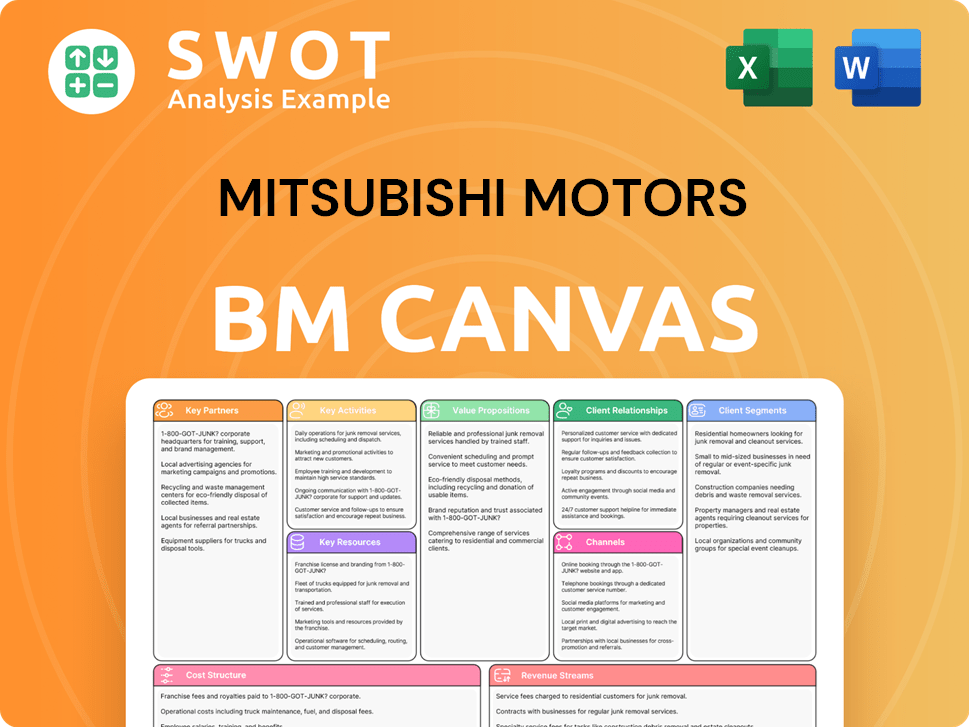
What Recent Changes Have Shaped Mitsubishi Motors’s Ownership Landscape?
Over the past few years, the ownership structure of Mitsubishi Motors has remained relatively consistent. The major shareholder continues to be Nissan Motor Co., Ltd., holding a significant stake of approximately 34%. This arrangement is a key component of the Renault-Nissan-Mitsubishi Alliance, which has shaped the company's strategic direction. There haven't been any major public announcements of significant changes through share buybacks or secondary offerings that would drastically alter the ownership structure.
Leadership changes within Mitsubishi Motors, particularly at the CEO and executive levels, often align with the strategic objectives of the Alliance. Industry trends, such as increased institutional ownership and the consolidation within the automotive sector, continue to influence companies like Mitsubishi Motors. Public statements from the company and industry analysts consistently highlight the importance of the Alliance for Mitsubishi Motors' future, especially in areas like electrification and shared platforms. The company's performance and future are closely tied to the dynamics within the Alliance.
| Ownership | Shareholder | Approximate Stake |
|---|---|---|
| Major Shareholder | Nissan Motor Co., Ltd. | 34% |
| Other Shareholders | Institutional Investors & Public | Remaining Shares |
| Strategic Partnership | Renault-Nissan-Mitsubishi Alliance | Strategic Alignment |
The Growth Strategy of Mitsubishi Motors emphasizes the importance of its alliances. The current ownership structure reflects the ongoing commitment of the Renault-Nissan-Mitsubishi Alliance, which is critical for Mitsubishi Motors' future. The stability in ownership provides a foundation for long-term strategic planning and investment in key areas like electric vehicles and shared platforms. Any future changes are likely to be influenced by the evolving dynamics within the Alliance and broader shifts in the global automotive market.
Nissan's 34% ownership gives it significant influence over Mitsubishi Motors' strategic decisions. This includes decisions about product development, market expansion, and resource allocation. The Alliance structure allows for shared technologies and cost efficiencies.
The Renault-Nissan-Mitsubishi Alliance plays a crucial role in Mitsubishi Motors' operations. This partnership enables the sharing of resources, technologies, and platforms. It also helps in navigating the complex global automotive landscape.
Trends like increased institutional ownership and consolidation in the automotive sector are significant. These trends can influence the company's strategic direction and financial performance. Understanding these trends is crucial for long-term planning.
Future ownership changes are likely to be driven by the Alliance's evolving dynamics. The global automotive landscape, including factors like electrification and market competition, will also play a role. The company's future is closely tied to strategic partnerships.
Mitsubishi Motors Porter's Five Forces Analysis
- Covers All 5 Competitive Forces in Detail
- Structured for Consultants, Students, and Founders
- 100% Editable in Microsoft Word & Excel
- Instant Digital Download – Use Immediately
- Compatible with Mac & PC – Fully Unlocked
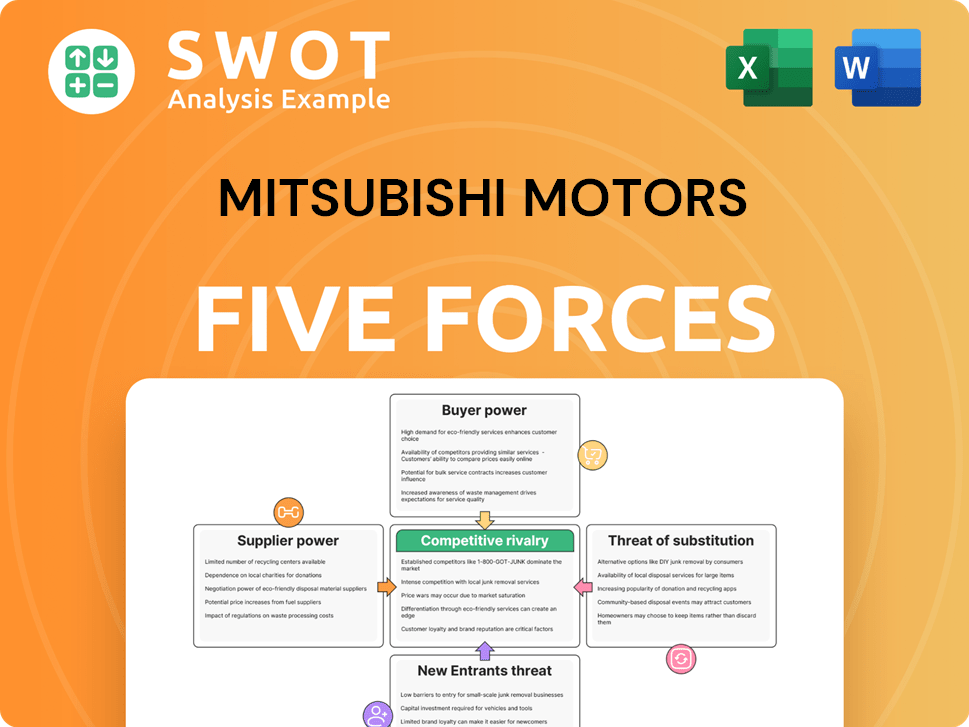
Related Blogs
- What are Mission Vision & Core Values of Mitsubishi Motors Company?
- What is Competitive Landscape of Mitsubishi Motors Company?
- What is Growth Strategy and Future Prospects of Mitsubishi Motors Company?
- How Does Mitsubishi Motors Company Work?
- What is Sales and Marketing Strategy of Mitsubishi Motors Company?
- What is Brief History of Mitsubishi Motors Company?
- What is Customer Demographics and Target Market of Mitsubishi Motors Company?
Disclaimer
All information, articles, and product details provided on this website are for general informational and educational purposes only. We do not claim any ownership over, nor do we intend to infringe upon, any trademarks, copyrights, logos, brand names, or other intellectual property mentioned or depicted on this site. Such intellectual property remains the property of its respective owners, and any references here are made solely for identification or informational purposes, without implying any affiliation, endorsement, or partnership.
We make no representations or warranties, express or implied, regarding the accuracy, completeness, or suitability of any content or products presented. Nothing on this website should be construed as legal, tax, investment, financial, medical, or other professional advice. In addition, no part of this site—including articles or product references—constitutes a solicitation, recommendation, endorsement, advertisement, or offer to buy or sell any securities, franchises, or other financial instruments, particularly in jurisdictions where such activity would be unlawful.
All content is of a general nature and may not address the specific circumstances of any individual or entity. It is not a substitute for professional advice or services. Any actions you take based on the information provided here are strictly at your own risk. You accept full responsibility for any decisions or outcomes arising from your use of this website and agree to release us from any liability in connection with your use of, or reliance upon, the content or products found herein.